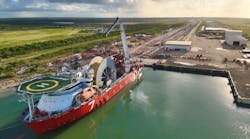Sea Commander, a remote unmanned well control buoy design first patented in 1980, was recently employed in its most sophisticated application to date. The project was for Australia's East Spar alliance, which commissioned the buoy to control four subsea gas wells, 62 km off the Northwest Shelf.
According to consultant engineers Resource Technology Developments (RTD) of Chepstow, UK, the system is capable of controlling and monitoring any number of wells and other types of facilities. Reliability is exceptional, says RTD's technical manager David Bone, "Up to 99.97%, but even in the event of a complete failure of main power systems, a system shutdown is avoided through application of back-up systems ensuring that oil or gas delivery is not interrupted.
Sea Commander is based on a design of buoy which has been in operation in the North Sea since 1981. The current version was designed to replace the conventional control link between an offshore production platform and outlying subsea production or injection facilities.
It employs a highly secure radio telemetry link to transmit control and monitoring signals between a computerized master control station located on the platform and a remote terminal unit located on a self-floating and stable field control station adjacent to the seabed facilities. A direct hydraulic or electric hydraulic control system effects local control of the seabed equipment.
An hydraulic power generation unit is housed in the field control station to provide for actuation of the seabed functions. Also housed is an independent power source and telemetry and radio equipment necessary to maintain the control and monitoring link between the master control station and the seabed equipment.
All support systems are also contained in the field control station. These include batteries, fuel system and navigation beacons. The unit can also be used to locate pumps and assorted equipment for remote chemical injection, along with chemicals such as MEG, TEG and corrosion inhibitor. The existing design can store up to 700 tonnes of fluid for use in chemical injection, or as additional fuel for onboard power operations.
During design of the buoy, RTD addressed the need for redundancy, duplicating or tripling equipment to achieve optimum operational reliability. Should maintenance be required, adverse working conditions have been minimized.
The atmosphere of the enclosed area in which offshore equipment is placed and where maintenance is undertaken is closely controlled. Movement is minimal, according to RTD, even during 100-year storm conditions. Heave is less than 1.5 meters and surge is around 12 meters with significant pitch. Maximum acceleration even under the worst conditions is approximately 0.3g.
Sea Commander can be used at any distance from its control center using duplicated high integrity communications systems. RTD claims several advantages over conventional subsea control systems, economy being one. The system reduces and simplifies equipment on the seabed and brings it to an accessible environment where it can be inspected and maintained without the use of costly DSVs.
Under normal circumstances, the high number of seabed umbilicals that radiate outward from a platform are prone to extensive damage. This is not the case with Sea Commander, which has none: the hydraulic control umbilical from the field control station to the seabed is either armored or protected by the steel tubular riser.
The buoyant structure is a development of the taut-moored spar concept which RTD designed for use in a high stability data acquisition system operated for the UK Department of Energy. Sea Commander is a larger version of this buoy. It is typically 45 meters long, seven meters in diameter, displacing 240 tons and with a deadweight of around 100 tons.
The buoy comprises a series of tubular sections of varying diameter. These form a column or spar, narrow at the surface with a wide buoyant section some 12 meters below mean sea level. The main buoyancy tank also provides attachments for the tethers which anchor the buoy to the seabed.
Sea Commander can be modified for use in shallow or deep water. In very shallow conditions a buoyant structure is employed based on the conventional catenary-moored buoy, similar to large automatic navigational buoys used by lighting authorities.
Design is similar to the taut-moored buoy, but mooring is achieved by using multiple mooring legs. These are chain catenaries with sinkers attached to high folding power anchors. Mooring design is specific to the selected location.
The system is capable of scanning initially a small number of wells, but is configurable to service additional groups and individual wells as the field development proceeds. Ultimately, says RTD, the control system will be able to scan all points within a maximum period of five minutes.
Copyright 1996 Offshore. All Rights Reserved.




